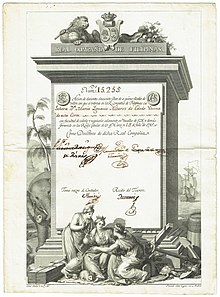17:
86:
97:, director of the Guipuzcoan Company, feared his company was about to be dissolved in the 1780s, he proposed to unite the trade of the Americas with that of Asia through the Philippines, incorporating the rights of the old company to the new one. His plan was adopted, and the Royal Company of the Philippines was established on March 10, 1783, before being institutionalized on March 10, 1785 by a royal decree of
175:
As the company quickly grew to establish monopolies in other branches of the
Spanish overseas trade, other companies, feeling the reduction of monopoly rights, began a struggle with the Royal Company of the Philippines. The most serious conflicts took place with the merchants of Manila and the
136:. The company quickly grew rich (at the end of 1785, its capital was 10 million pesos) and sought to modernize the archipelago's export capacities; it quickly took control of the other companies and preserved the already existing commercial strategy that favored export crops:
194:
These problems led to a progressive decline of the company from 1794, becoming practically inoperative at the late 18th to early 19th century. The company ceased its functions in 1829, after the fall of the
288:
293:
222:"Real Compañía de Filipinas. Circunstancias del nacimiento de la RCF [Royal Company of the Philippines. Circumstances of the birth of the RCF]"
132:
each, with the incipient
Spanish financial companies participating in the operation. Later, it increased its capitalization with the issuance of
298:
181:
167:
was contracted with the Royal
Company of the Philippines in 1787, which maintained a line with the Philippines during the 19th century.
66:
159:
The
Spanish government secured the link with its provinces of the Spanish East Indies through this company. Until then he had awarded
69:
and all surrounding trade. It weakened in importance until it was dissolved in the 1830s. Its direct predecessor was that of the
283:
16:
221:
313:
108:(then a colony of the Spanish Empire) and the mother country. The royal decree also provided for closing the port of
191:
entered the service of the company in 1796, where he became secretary and, later, director on March 30, 1815.
70:
308:
21:
303:
259:
188:
128:
The Royal
Company of the Philippines was founded with an initial capital of 3,000 shares of 250
200:
98:
94:
8:
58:
50:
85:
196:
133:
26:
199:, and was declared extinct by decree of October 6, 1834 during the regency of
277:
117:
112:
to any foreign vessel. Therefore, only the company could import goods from
105:
30:
246:
Diccionario geografico, estadistico, historico de las Islas
Filipinas
113:
177:
62:
74:
34:
153:
141:
137:
109:
104:
The purpose of the company was to promote direct trade between
38:
149:
145:
129:
184:, which maintained Asian trade as the first power.
289:Trading companies established in the 18th century
275:
176:Filipinos themselves, who used the route to
243:
163:contracts to different companies. The last
219:
61:founded in 1785, directed to establish a
101:, being directed by Francisco Cabarrús.
89:Decree of the Philippine Company in 1785
84:
15:
248:. Jos. C. de la Peña. pp. 149–162.
170:
294:History of the Philippines (1565–1898)
276:
180:for their own activities, or with the
299:Defunct companies of the Philippines
239:
237:
235:
13:
14:
325:
232:
47:Royal Company of the Philippines
25:, large-format oil on canvas by
260:"The Board of the Philippines"
252:
213:
1:
226:Auñamendi Eusko Entziklopedia
206:
284:Companies of the Philippines
22:The Board of the Philippines
7:
123:
80:
10:
330:
314:Trading companies of Spain
220:Ojanguren, Garate (2018).
55:Real Compañía de Filipinas
264:Fundacion Goya en Aragon
197:Spanish colonial empire
244:Buzeta; Bravo (1850).
90:
42:
88:
19:
171:Monopoly and Decline
120:or the Philippines.
99:Charles III of Spain
309:Chartered companies
67:Spanish Philippines
189:José Luis Munárriz
114:New Spanish Mexico
95:Francisco Cabarrús
91:
71:Guipuzcoan Company
43:
59:chartered company
321:
304:Trade monopolies
268:
267:
256:
250:
249:
241:
230:
229:
217:
329:
328:
324:
323:
322:
320:
319:
318:
274:
273:
272:
271:
258:
257:
253:
242:
233:
218:
214:
209:
173:
126:
106:the Philippines
83:
12:
11:
5:
327:
317:
316:
311:
306:
301:
296:
291:
286:
270:
269:
251:
231:
211:
210:
208:
205:
182:United Kingdom
172:
169:
125:
122:
82:
79:
27:Francisco Goya
9:
6:
4:
3:
2:
326:
315:
312:
310:
307:
305:
302:
300:
297:
295:
292:
290:
287:
285:
282:
281:
279:
265:
261:
255:
247:
240:
238:
236:
227:
223:
216:
212:
204:
202:
198:
192:
190:
185:
183:
179:
168:
166:
162:
157:
155:
151:
147:
143:
139:
135:
131:
121:
119:
115:
111:
107:
102:
100:
96:
87:
78:
76:
72:
68:
64:
60:
56:
52:
48:
40:
36:
32:
28:
24:
23:
18:
263:
254:
245:
225:
215:
193:
186:
174:
164:
160:
158:
127:
103:
92:
54:
46:
44:
20:
201:Isabella II
187:The writer
31:Goya Museum
278:Categories
207:References
29:in 1815 (
178:Acapulco
124:Activity
81:Founding
63:monopoly
57:) was a
75:Caracas
65:on the
51:Spanish
35:Castres
154:cotton
150:spices
142:coffee
138:indigo
110:Manila
39:France
146:sugar
134:bonds
130:pesos
118:China
165:seat
161:seat
45:The
93:As
73:of
280::
262:.
234:^
224:.
203:.
156:.
152:,
148:,
144:,
140:,
116:,
77:.
53::
41:).
37:,
33:,
266:.
228:.
49:(
Text is available under the Creative Commons Attribution-ShareAlike License. Additional terms may apply.

